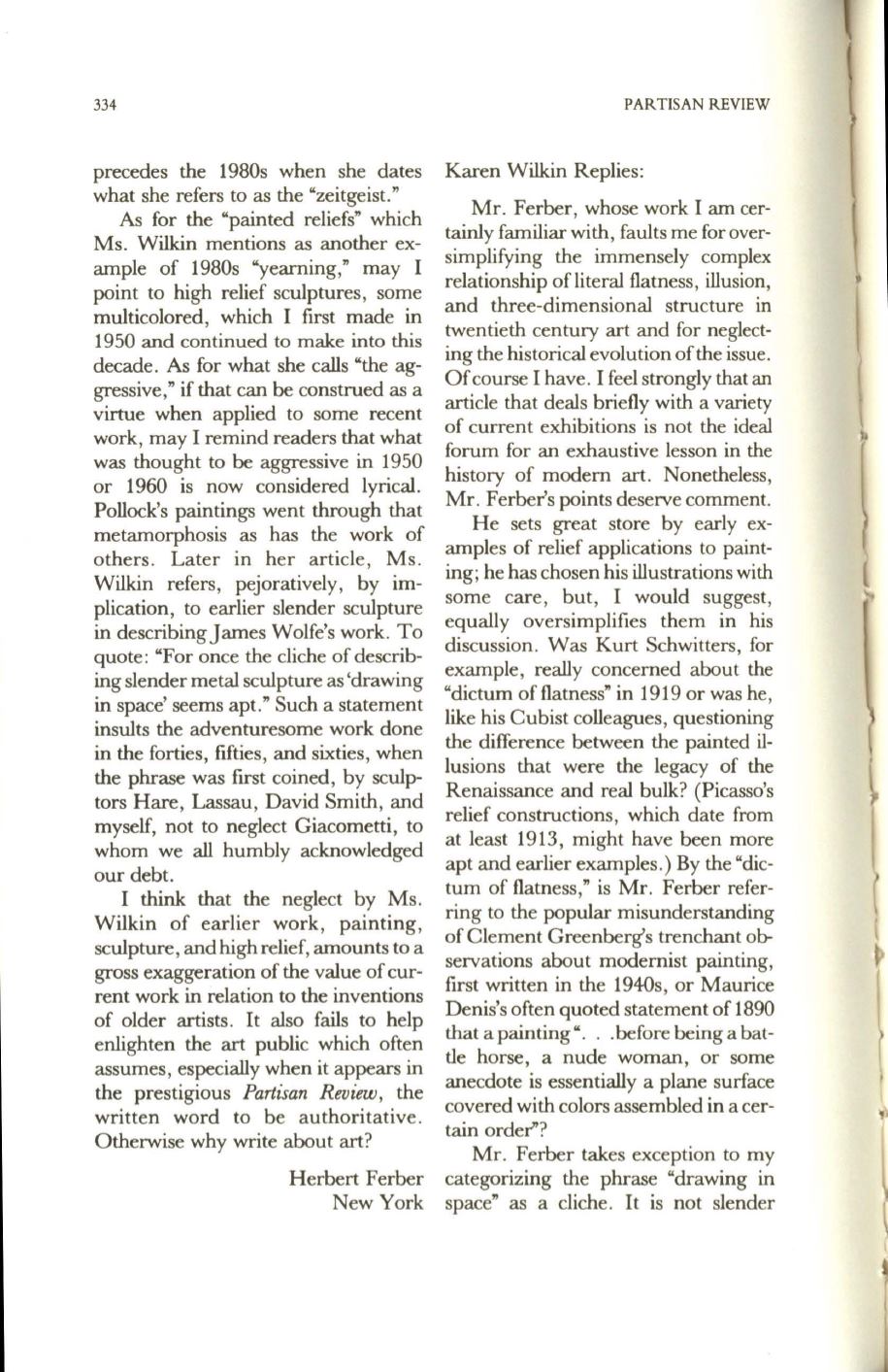
334
precedes the 1980s when she dates
what she refers to as the "zeitgeist."
As for the "painted reliefs" which
Ms. Wilkin mentions as another ex–
~ple
of .1980s "yearning," may I
pomt to high relief sculptures, some
multicolored, which I first made in
1950 and continued to make into this
decade. As for what she calls "the ag–
gressive," if that can be construed as a
virtue when applied to some recent
work, may I remind readers that what
was thought to be aggressive in 1950
or 1960 is now considered lyrical.
Pollock's paintings went through that
metamorphosis as has the work of
others . Later in her article, Ms .
~ilki~
refers, pejoratively, by im–
phcatlOn, to earlier slender sculpture
in describing James Wolfe's work. To
quote: "For once the cliche of describ–
~g slen~er
metal sculpture as 'drawing
In space seems apt." Such a statement
insults the adventuresome work done
in the forties, fifties , and sixties, when
the phrase was first coined, by sculp–
tors Hare, Lassau, David Smith, and
myself, not to neglect Giacometti, to
whom we all humbly acknowledged
our debt.
I think that the neglect by Ms.
Wilkin of earlier work, painting,
sculpture, and high relief, amounts to a
gross exaggeration of the value of cur–
rent work in relation to the inventions
of ?lder artists.
It
also fails to help
enlighten the art public which often
assumes, especially when it appears in
the prestigious
Partisan Review
the
written word to be
authorit~tive .
Otherwise why write about art?
Herbert Ferber
New York
PARTISAN REVIEW
Karen Wilkin Replies:
Mr. Ferber, whose work I am cer–
tainly familiar with , faults me for over–
simplifying the immensely complex
relationship of literal flatness illusion
and three-dimensional
st~cture i~
~entieth
century art and for neglect–
Ing the historical evolution ofthe issue.
Of.course I have. I feel strongly that an
article that deals briefly with a variety
of current exhibitions is not the ideal
forum for an exhaustive lesson in the
history of modern art. Nonetheless
Mr. Ferber's points deserve comment:
He sets great store by early ex–
:unples of relief applications to paint–
Ing; he has chosen his illustrations with
some care, but, I would suggest,
equally oversimplifies them in his
discussion. Was Kurt Schwitters for
example, really concerned abou; the
"dictum of flatness" in 1919 or was he
like
h~s
Cubist colleagues,
questionin~
the difference between the painted il–
lusions that were the legacy of the
Re.naissance and real bulk? (Picasso's
rehef constructions, which date from
at least 1913, might have been more
apt and earlier examples.) By the "dic–
tum of flatness ," is Mr. Ferber refer–
ring to the popular misunderstanding
of Clement Greenberg's trenchant ob–
servati~ns a~ut
modernist painting,
first wntten m the 1940s, or Maurice
Denis's often quoted statement of 1890
that a painting". . .before being a bat–
tle horse, a nude woman, or some
anecdote is essentially a plane surface
covered with colors assembled in a cer–
tain order"?
Mr..
~erber
takes exception to my
categonzlng the phrase "drawing in
space" as a cliche . It is not slender


